
Features
Operations
staying balanced
The drive for accurate information and forecasts has never been more intense, as corporate Canada tries to determine which direction to take with business aviation ownership and operations.
May 6, 2011 By Rob Seaman
The drive for accurate information and forecasts has never been more intense, as corporate Canada tries to determine which direction to take with business aviation ownership and operations. Determining when the business aviation market will rebound from its current sluggish state is one of the biggest challenges facing manufacturers, operators and financial analysts alike. And whether it’s related to aircraft acquisition, replacement, business development or expansion, the quest for credible information is steady and determined.
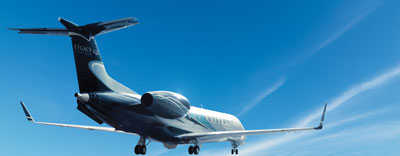 |
|
| PHOTO: EMBRAER
|
“What do you think the market will do,” or “do you think we have hit bottom yet” or “is it time to make a move”? – they’re all common questions. The answers most often depend on a number of things: which geographic market you’re in, which industry segment you represent and which type of aircraft you’re talking about.
Regardless of the information in hand, however, it remains a guessing game when determining an accurate recovery flight path. Political and social unrest in the Middle East has driven up the price of oil, a key cause of the current recession. The devastation following the earthquake and tsunami this past March in Japan resulted in severe economic trauma throughout the Pacific Rim, and reverberations are sure to follow in North America. The interruption in microchip production in Japan alone will have severe effects on technological development and, as a result, the entire aviation industry.
Leading the way
In spite of current political and social uncertainty on the world stage, however, many Canadian companies in the business aviation sector are experiencing positive outlooks.
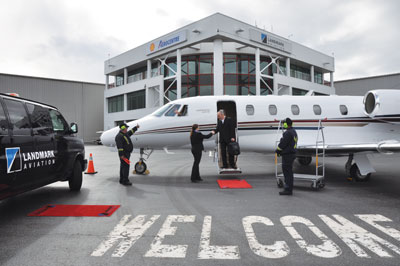
|
|
| Canadian manufacturers, operators and FBOS are all trying to set a proper course in dealing with the sluggish economy. Photo: Landmark Aviation
|
Montreal’s Bombardier Aerospace is leading the pack when it comes to Canadian success stories in business aviation. In its annual forecast and overview of the industry, Bombardier stated sales last year rose to “normal levels” and, subsequently, pre-owned inventories declined. In addition, business jet utilization, as measured by aircraft movements, was up significantly year-over-year. And as anticipated, positive net orders for business jets have resumed, albeit at a low rate. Furthermore, business aviation penetration in the fastest expanding world economies – China and India in particular – is accelerating. So, the stage is set for a full industry recovery.
Optimism is also reflected in Bombardier’s 20-year industry delivery forecast, which predicts 26,000 business jet deliveries worth $661 billion, of which 10,500 deliveries worth $254 billion are anticipated in the period from 2010 to 2019. Similarly, 15,500 deliveries worth $407 billion will be made in the period from 2020 to 2029.
The worldwide business jet fleet was approximately 14,200 aircraft at the end of 2009 and is expected to grow by a compound annual growth rate (CAGR) of 3.6 per cent over the forecast period to amount to approximately 29,000 aircraft by 2029 (net of aircraft retirements).
The Bombardier report also suggests that although demand has been slow to recover since the beginning of 2010, expectations are the industry order intake is set to return to positive territory this year – and things are off to a good start based on recent announcements.
For example, Bombardier announced in early March its largest business jet order ever: up to 120 business jets from its Global family to NetJets Inc., a subsidiary of Warren Buffett’s Berkshire Hathaway Inc. The initial order was for 50 new business jets: 30 Global 5000 Vision and Global Express XRS Vision aircraft, and 20 new Global 7000 and Global 8000 aircraft, to be delivered in 2017. It’s a US$2.8 billon deal that could be worth up to US$6.7 billion, provided the option for 70 more Global jets is picked up. Steve Ridolfi, Bombardier business aircraft president, was understandably thrilled with the deal. “We are very proud to have NetJets, the worldwide leader in private aviation, select the Bombardier Global aircraft family,” he said.
Over the next three years, Bombardier’s order intake should return to the level reached during the last peak. The majority of orders over the next 10 years will likely come from North America, Europe, Latin America, Russia, China, Asia, Middle East, India and Africa.
“This past year has been challenging yet positive,” said Pierre Beaudoin, Bombardier’s president and chief executive officer. “In aerospace, we seem to have turned the corner with business jet orders picking up substantially in the fourth quarter of 2010. To further strengthen our product leadership position, we continue to make progress on the development of new products within our business and commercial aircraft segments, both of which have healthy long-term growth prospects.”
Flight of fancy
Bombardier’s fortunes are encouraging and positive numbers on business aviation flight activity point to resurgence in the market, according to TraqPak data from aviation services company ARGUS.
In December 2010, there was a 4.4 per cent year-over-year increase in business flight activity from 2009, bolstered by a double-digit-percentage resurgence in Part 91 corporate operations in the U.S. Broken down by aircraft category, mid-size jet activity increased 6.5 per cent, followed by large-cabin jet activity (4.4 per cent). This should spell positive things for the Canadian market as well.
Other positive trends surfaced in the year-end report from the GAMA (General Aviation Manufacturer’s Association). Speaking at GAMA’s “State of the Industry” press conference in February, GAMA chairman John Rosanvallon, president and CEO of Dassault Falcon, reported that, although the global economic downturn continued to negatively impact general aviation manufacturers in 2010, signs of recovery are on the horizon.
“Our industry experienced another challenging year that required many manufacturers to continue to make careful decisions about production schedules, employment and product development,” said Rosanvallon. “However, despite the pain caused by the downturn, we are now seeing strong GDP growth on a global level and corporate profits are up. This bodes well for general aviation’s future as shipments have traditionally lagged an economic recovery by one to two years.”
Rosanvallon underscored other indicators that point to a turnaround. “Markets other than North America and Europe are leading the global recovery, flying hours are steadily on the rise, and there are two critical U.S. tax provisions in place that will help our industry recover . . . Two areas of concern continue to be the sluggish used market and the lack of third-party financing, especially for the middle and light end of the business jet segment, as well as turboprops and piston engine powered airplanes.”
The GAMA report reveals worldwide shipments of general aviation airplanes declined for the third year in a row to a total of 2,015 units, an 11.4 per cent decrease over the previous year’s total of 2,274 airplanes. Worldwide general aviation billings, nevertheless, rose by 1.2 per cent in 2010 to $19.7 billion. Last year was the third-best year ever for total industry billings, driven by deliveries of long-range, large-cabin aircraft. This part of the business jet segment remained relatively stable during the recession with delivery rates increasing in 2010.
As Rosanvallon states, the piston and turbo prop segment continues to struggle. The piston airplane segment shipped 889 units in 2010, compared to 963 units in 2009, a 7.7 per cent decline. The turboprop sector was down 17.7 per cent, shipping 363 units in 2010, compared to 441 units the previous year. The business jet sector declined 12.3 per cent with 763 airplanes shipped, compared to 870 airplanes the previous year.
A view from the top
As president and CEO of the Canadian Business Aviation Association (CBAA), Sam Barone has an excellent read on where the business aviation market is headed. And although he has some trepidation about some aspect of the business aviation market, the long-term drivers of growth for business jets remain solid – wealth creation, emerging markets, increased globalization, replacement demand and market access.
The most compelling concern for Canadian corporate operators this year will be the certification of business aviation going back to Transport Canada’s sole domain/control. As Barone notes, it will create a more complex operating environment for business aviation operators. (see “Heading toward a common goal,” pg. 62). Other top issues Canadian business aviators will face in 2011 include the EU environmental compliance/Canadian initiatives; increased security screening procedures at FBOs; and border management issues with the TSA/CBP in relation to the LASP regulations.
“With the new CBAA going forward, we will continue to focus on advocacy and representation of our members in Ottawa and beyond,” says Barone. And the fact the association has been able to attract people like Merlin Preuss, former head of Civil Aviation at Transport Canada, says a lot about the validity of its vision and mission going forward.
Overall, 2011 looks like a promising year for corporate aviation in Canada and around the world – but just how it will unfold remains a hot topic of conversation.
| Ready and able There’s a whole new crop of luxurious business jets battling for market share. Here’s a look at some of the biggest newsmakers. During the first quarter of 2011, Embraer delivered eight executive jets, indicating the market is continuing its steady recovery this year. Operations have also begun at the new industrial plant in Melbourne, Fla., to deliver Phenom jets to the North American market. |
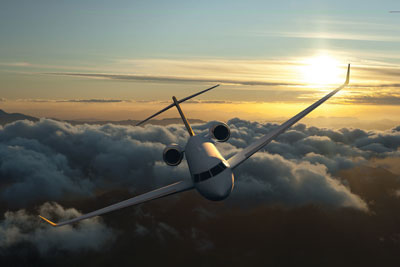 Bombardier Global 7000, Global 8000 – Launched in the fall of 2010, these ultra-long-range business jets are set to enter service in 2016 and 2017, respectively. The two jets are expected to challenge Gulfstream’s G650 for control of the long-range business jet market. Both aircraft will have a high-speed cruising speed of Mach 0.90. The 7000 will have a range of 7,300 nautical miles, whereas the 8000’s range will be 7,900 nm. The new jets – with a price tag of $65 million each – will feature General Electric’s new emission-cutting TechX engine, making them both powerful and environmentally conscious. Said Steve Ridolfi, president of Bombardier Business Aircraft: “The Global 7000 and Global 8000 jets will give our customers the reliability to reach more destinations non-stop than ever before.”
Bombardier Global 7000, Global 8000 – Launched in the fall of 2010, these ultra-long-range business jets are set to enter service in 2016 and 2017, respectively. The two jets are expected to challenge Gulfstream’s G650 for control of the long-range business jet market. Both aircraft will have a high-speed cruising speed of Mach 0.90. The 7000 will have a range of 7,300 nautical miles, whereas the 8000’s range will be 7,900 nm. The new jets – with a price tag of $65 million each – will feature General Electric’s new emission-cutting TechX engine, making them both powerful and environmentally conscious. Said Steve Ridolfi, president of Bombardier Business Aircraft: “The Global 7000 and Global 8000 jets will give our customers the reliability to reach more destinations non-stop than ever before.”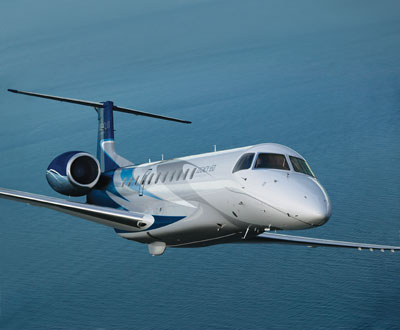 Embraer Legacy G650, Legacy 450 and 500 – The Legacy G650, an extended-range variant of the Brazilian aircraft manufacturer’s Legacy G600 was launched in October 2009 as a rival to Bombardier’s large-cabin Challenger 605, Dassault Falcon’s 2000LX, and Gulfstream’s G350 and G450. The Legacy 650 jet has been certified in the U.S. and the first Legacy was delivered in 2010. It features a 3,900 nm range with four passengers in the most spacious cabin in its class. Embraer is also working to bring its Legacy 450 and 500 business jets to market in 2013 and 2014.
Embraer Legacy G650, Legacy 450 and 500 – The Legacy G650, an extended-range variant of the Brazilian aircraft manufacturer’s Legacy G600 was launched in October 2009 as a rival to Bombardier’s large-cabin Challenger 605, Dassault Falcon’s 2000LX, and Gulfstream’s G350 and G450. The Legacy 650 jet has been certified in the U.S. and the first Legacy was delivered in 2010. It features a 3,900 nm range with four passengers in the most spacious cabin in its class. Embraer is also working to bring its Legacy 450 and 500 business jets to market in 2013 and 2014.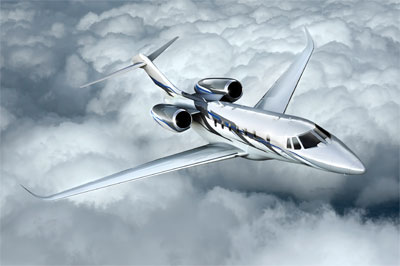 Cessna Citation Ten – The enhanced version of the Citation X will fly higher and cruise faster than the current model, carry more payload, burn less fuel and be a nicer ride for passengers. The Ten will have a range of 3,242 nm, and operators can fly between a variety of destinations in North America and Europe with just one refuelling stop. The Citation Ten has upgraded Rolls-Royce AE3007C2 turbofan engines with new fans, elliptical winglets and Garmin G5000 avionics.
Cessna Citation Ten – The enhanced version of the Citation X will fly higher and cruise faster than the current model, carry more payload, burn less fuel and be a nicer ride for passengers. The Ten will have a range of 3,242 nm, and operators can fly between a variety of destinations in North America and Europe with just one refuelling stop. The Citation Ten has upgraded Rolls-Royce AE3007C2 turbofan engines with new fans, elliptical winglets and Garmin G5000 avionics.